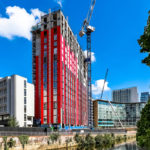 The retrofitting of high-rise buildings in the UK can face several challenges. In this article, James Brackenreed-Johnston, Head of Facades at the A. Proctor Group, examines some common problems encountered during the retrofitting process.
The retrofitting of high-rise buildings in the UK can face several challenges. In this article, James Brackenreed-Johnston, Head of Facades at the A. Proctor Group, examines some common problems encountered during the retrofitting process.
Structural limitations — retrofitting measures such as adding insulation or renewable energy systems can be challenging to integrate into existing structures without compromising their stability.
Lack of space — high-rise buildings often have limited space for retrofitting interventions. This can make incorporating energy-efficient solutions like installing additional insulation, renewable energy systems, or upgrading ventilation systems difficult.
Access and logistics — coordinating construction activities, getting equipment and materials to upper floors, and managing the disruption caused by retrofitting can be a highly complex procedure.
Cost considerations — addressing structural changes or extensive energy performance upgrades can become costly. Balancing this cost with the potential long-term savings on energy bills and the building’s sustainability can be a complex decision for building owners and managers.
Planning and regulations — Retrofitting high-rise buildings in the UK involves compliance with various planning and Building Regulations. As a result, meeting these standards and obtaining the necessary permits can prove to be a time-consuming and challenging.
Tenant considerations — retrofitting may disrupt the occupants’ lives during construction. As high-rise buildings often consist of multiple residential or commercial units, managing the needs and expectations of tenants or occupants can be a significant challenge. Therefore, it is vital that this is factored into the design and planning from the outset.
Despite these challenges, retrofitting high-rise buildings in the UK is crucial for improving energy efficiency, reducing carbon emissions, and enhancing the overall sustainability of the built environment. The A. Proctor Group has an extensive portfolio of innovative product solutions designed for retrofitting high-rise buildings and maximising performance and energy efficiency. Their experienced technical support team is on hand to assist local authorities and social housing providers in developing the optimal solutions to suit individual project requirements.
In August, Mathew Spiller, National Technical Sales Manager — Ground Gas Protection at A. Proctor Group, discussed the latest guidance on protective measures for new buildings to reduce the risk of radon. You can read that article here.










